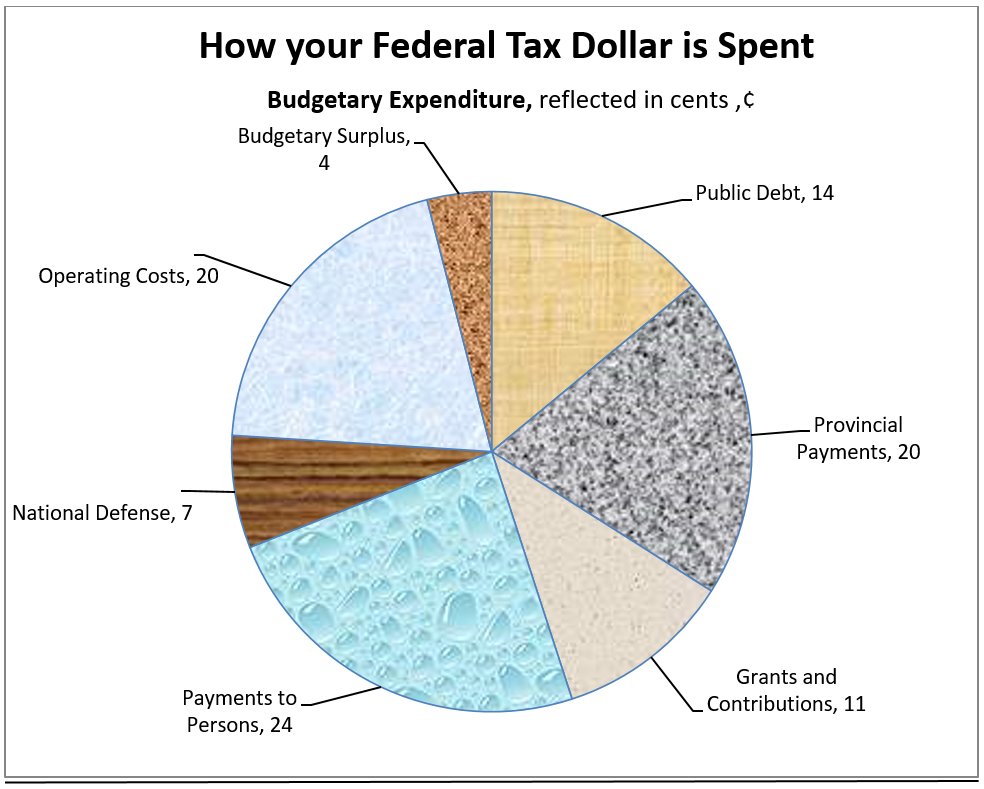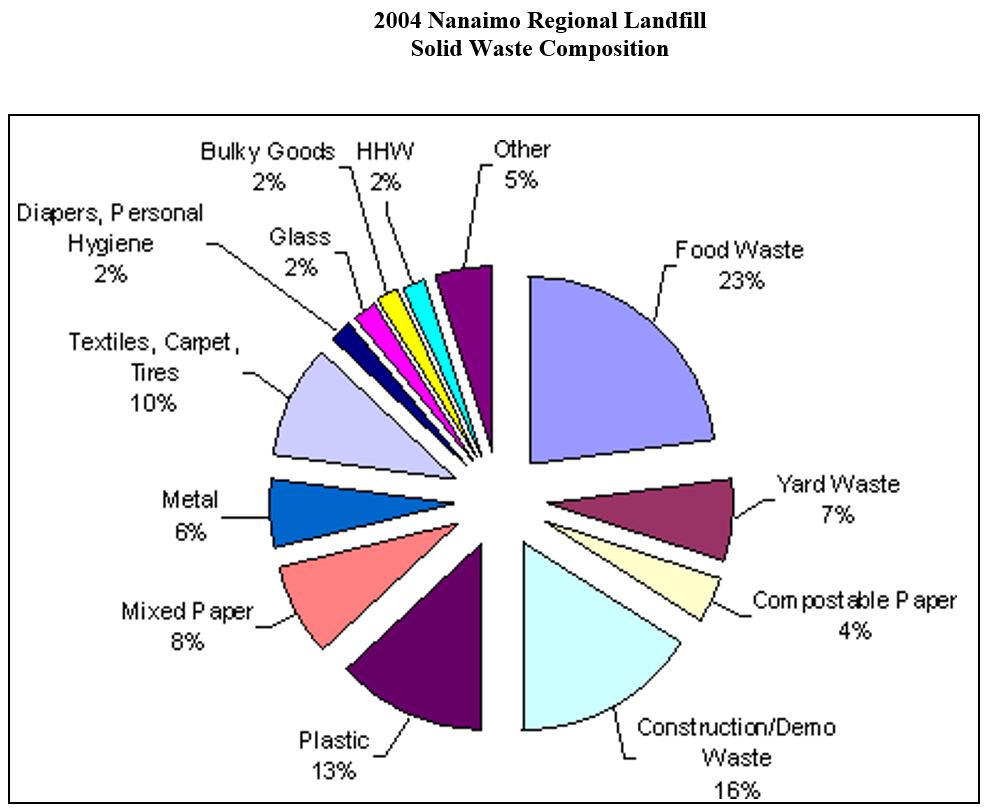Unit 5: Statistics
Topic D: Circle Graphs (“Pie Graphs”)
Circle graphs show how the parts of something compare to each other. Circle graphs also give a good picture of each part compared to the whole thing. In a circle graph or pie graph, the complete circle is the whole thing. The parts of a circle graph may be identified with a percentage. The total of the parts must be 100%.
Graph 1

- What is the biggest expense of the federal government?
- How much of each federal dollar is spent in actually operating the government business?
- What part of the federal dollar is spent on defence?
- How much of each dollar is spent on Provincial Payments? Write this amount as a percent.
- What is the smallest expenditure of the federal government? Write this amount as a percent.
Answers to Graph 1
- Payments to Persons
- 20¢
- 7¢
- 20¢; 20%
- Budgetary Surplus; 4%
Graph 2
2004 Nanaimo Regional Landfill Solid Waste Composition

- What makes up the largest part of the waste in the landfill site?
- What four categories contribute equal weight to the landfill site?
- In a municipality of 139,000 people, the amount of waste going to a landfill site in one day is 150 tonnes.
- What is the mass of plastics?
- What is the mass of yard waste?
- What is the mass of construction/demo waste?
- If all the food waste was composted, how many tonnes of waste would not end up in the landfill each day?
- The plastics category can be separated into these categories:
- 6% Non-recyclable mixed plastics
- 4% film plastic
- 3% recyclable rigid food containers
If all the 3% recyclable rigid food containers were actually recycled, how many tonnes of waste would not end up in the landfill?
Answers to Graph 2
- Food waste
-
- Diapers, Personal Hygiene
- Glass
- Bulky Goods
- HHW (Household Hazardous Waste
-
- 19.5 tonnes
- 10.5 tonnes
- 24 tonnes
- 34.5 tonnes
- 4.5 tonnes
Image Descriptions
Graph 1 (Circle Graph)
A circle graph showing the Canadian tax dollar was spent in the 2007-2008 fiscal year.
- The whole circle represents one dollar of the Canadian budgetary expenditure.
- Each part reflects one of the specific expenses, reflected in cents to the dollar, ¢. The included parts are (clockwise from top): Public Debt, Provincial Payments, Grants and Contributions, Payments to Persons, National Defense, Operating Costs, and Budgetary Surplus.
The circle graph data is represented in the following table:
| Expense | Expenditure, reflected in cents to the dollar, ¢ |
|---|---|
| Public Debt | 14 |
| Provincial Payments | 20 |
| Grants and Contributions | 11 |
| Payments to Persons | 24 |
| National Defense | 7 |
| Operating Costs | 20 |
| Budgetary Surplus | 4 |
| Source: Where Your Tax Dollar Goes – 2007-2008 (Department of Finance Canada) | |
Graph 2 (Circle Graph)
A circle graph showing the solid waste composition of the Nanaimo Regional Landfill in 2004.
- The whole circle represents the total composition of solid waste in the Nanaimo Regional Landfill in 2004.
- Each part reflects one element of the total composition. The included elements are (clockwise from top): Food Waste, Yard Waste, Compostable Paper, Construction/Demo Waste, Plastic, Mixed Paper, Metal, Textiles & Carpet & Tires, Diapers & Personal Hygiene, Glass, Bulky Goods, HHW, and Other.
The circle graph data is represented in the following table:
| Element of Waste | Percentage of Total |
|---|---|
| Food Waste | 23% |
| Yard Waste | 7% |
| Compostable Paper | 4% |
| Construction/Demo Waste | 16% |
| Plastic | 13% |
| Mixed Paper | 8% |
| Metal | 6% |
| Textiles, Carpet, Tires | 10% |
| Diapers, Personal Hygiene | 2% |
| Glass | 2% |
| Bulky Goods | 2% |
| HHW | 2% |
| Other | 5% |
| Source: 2004 Nanaimo Regional Landfill Solid Waste Composition | |

